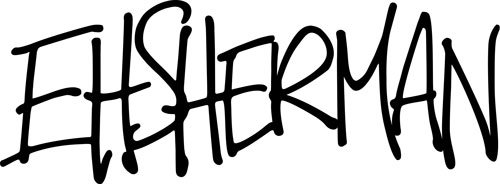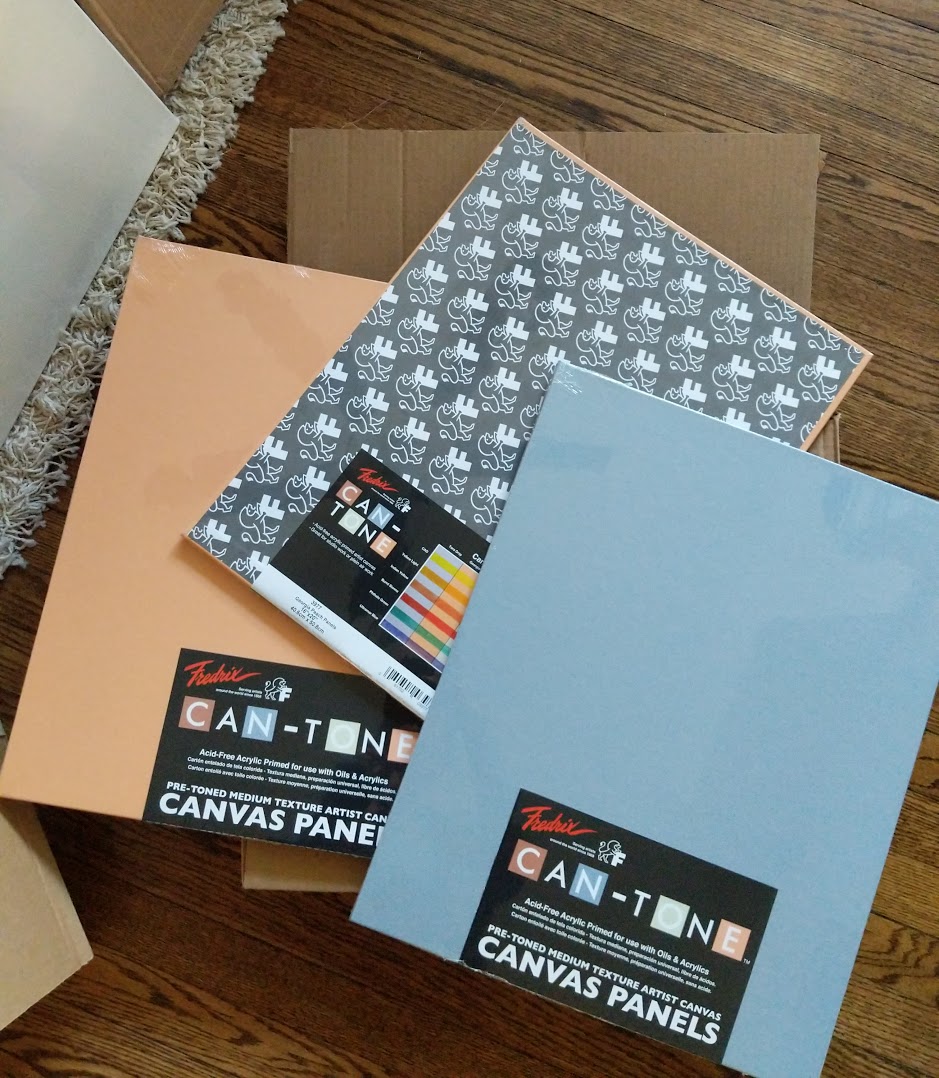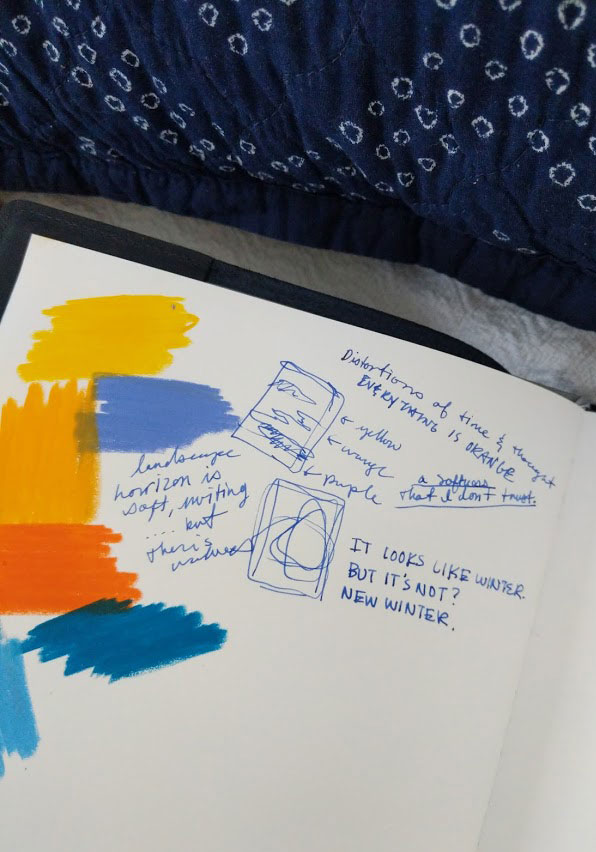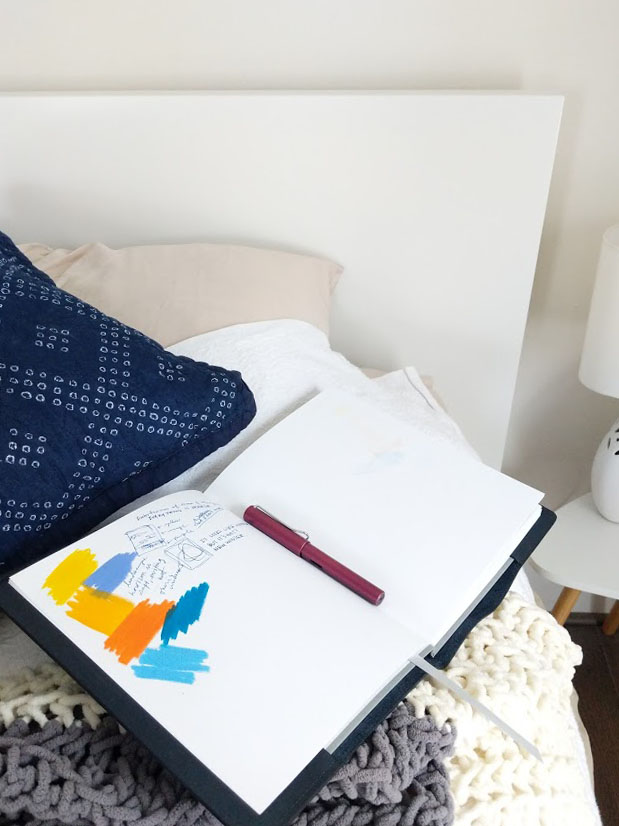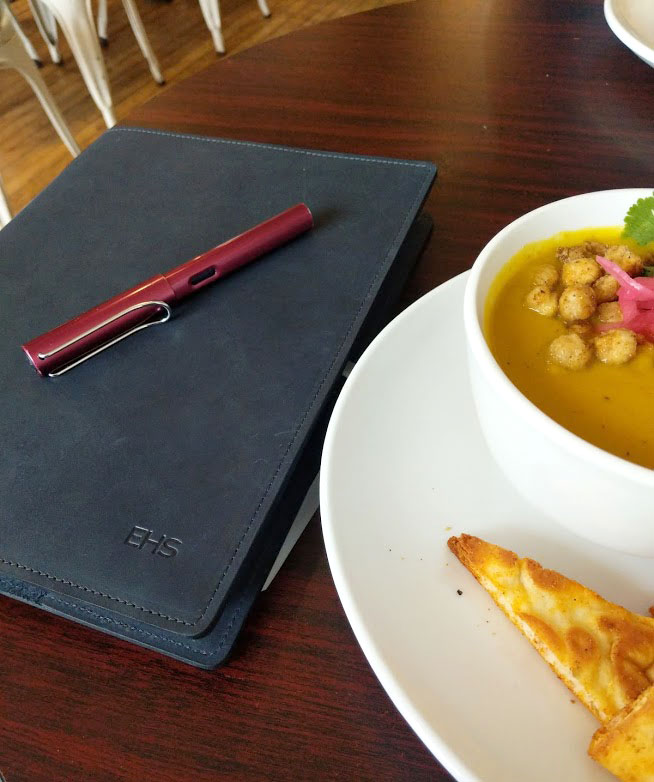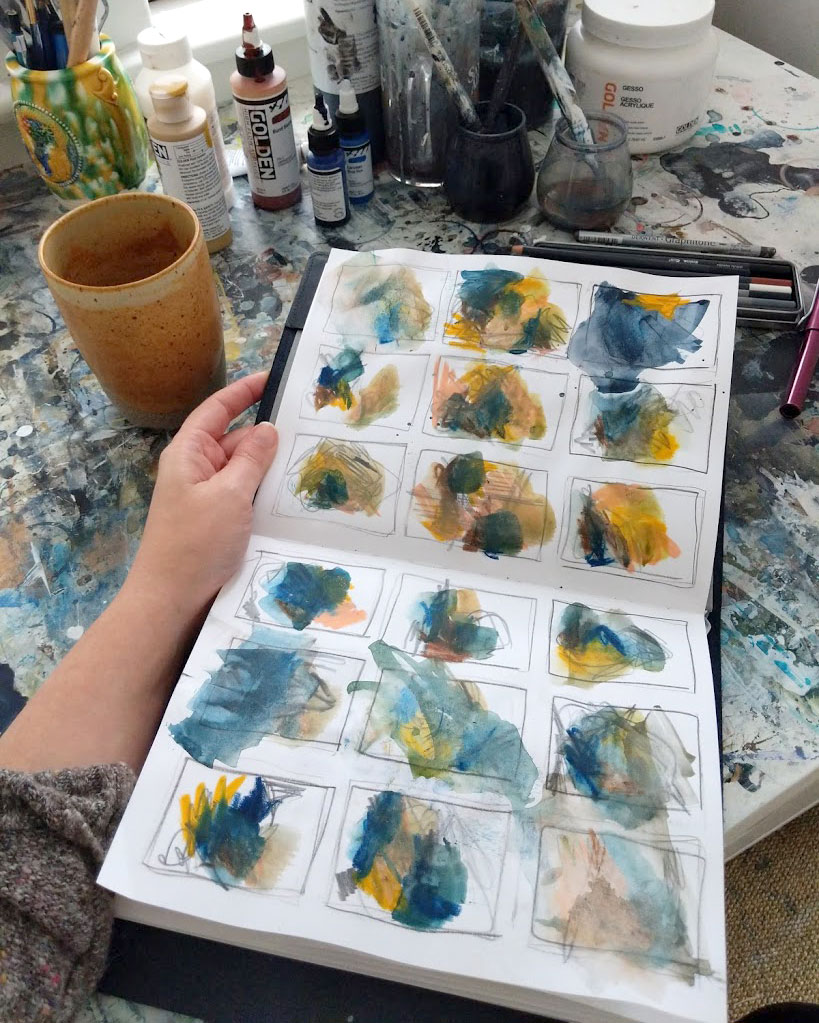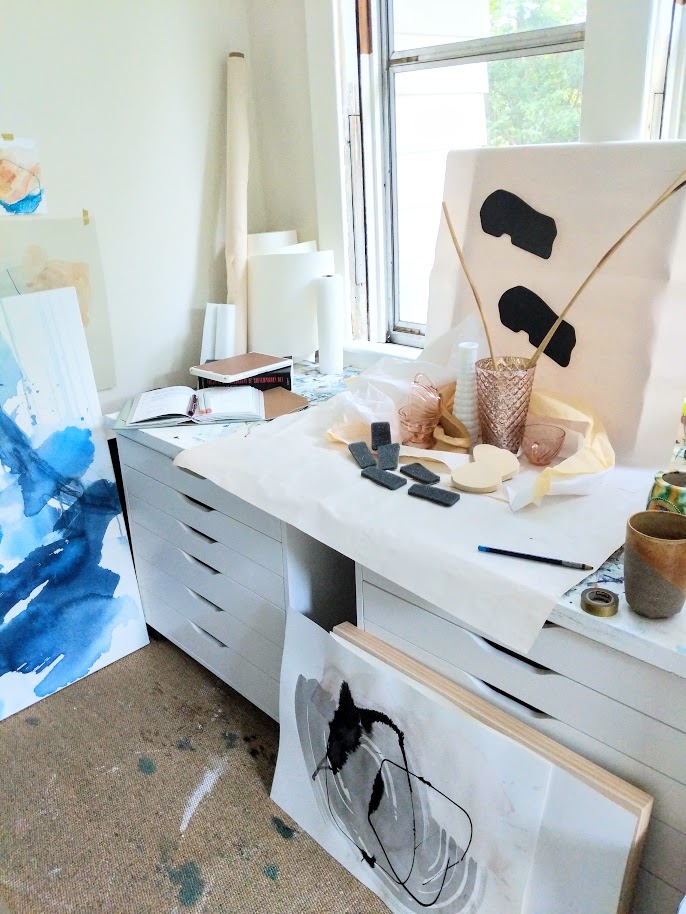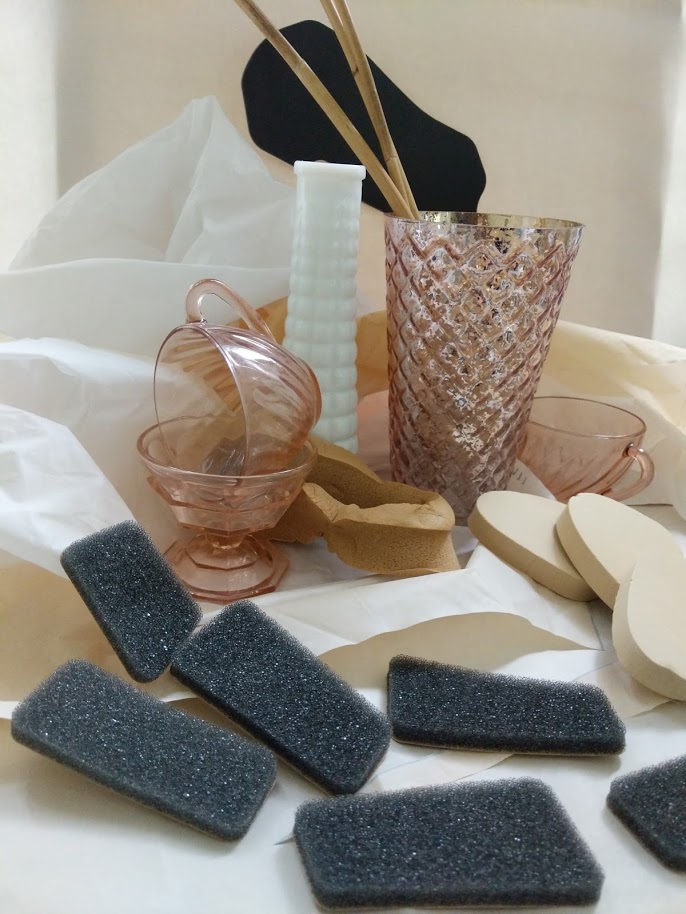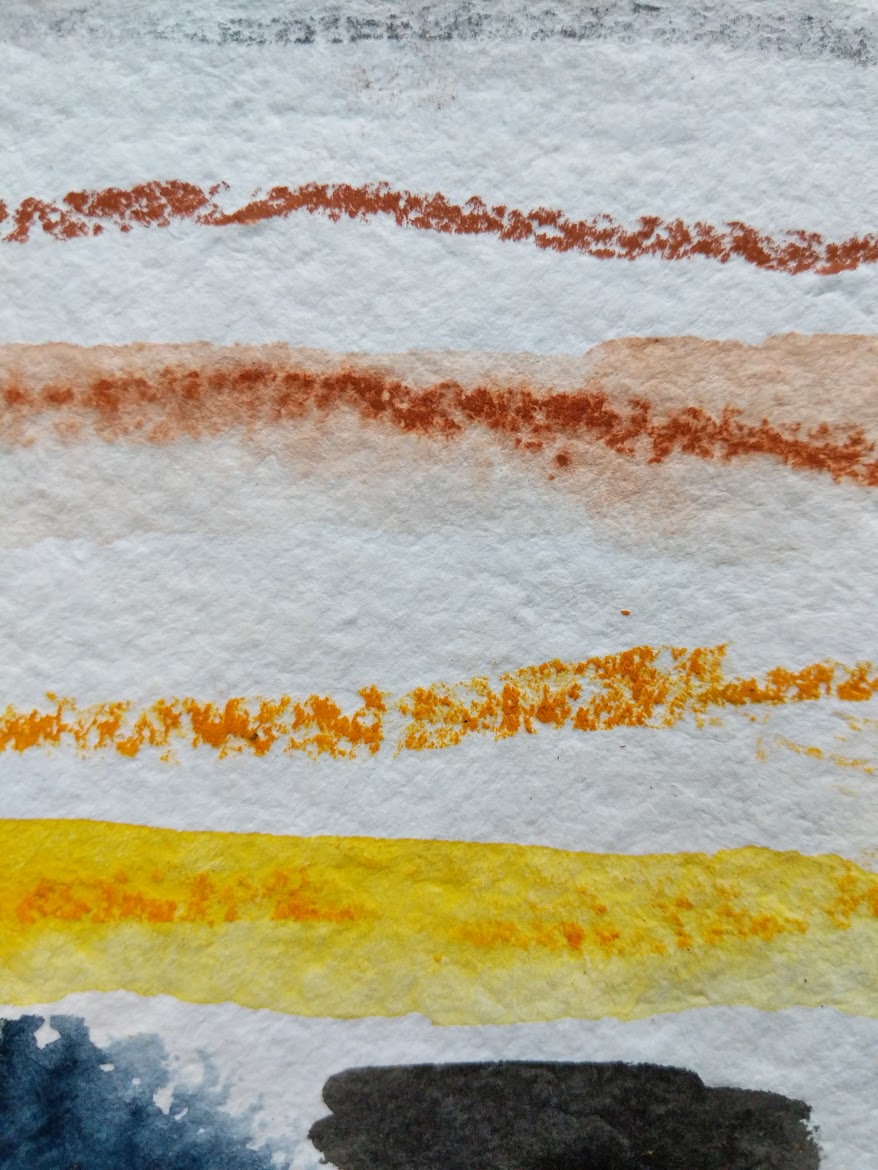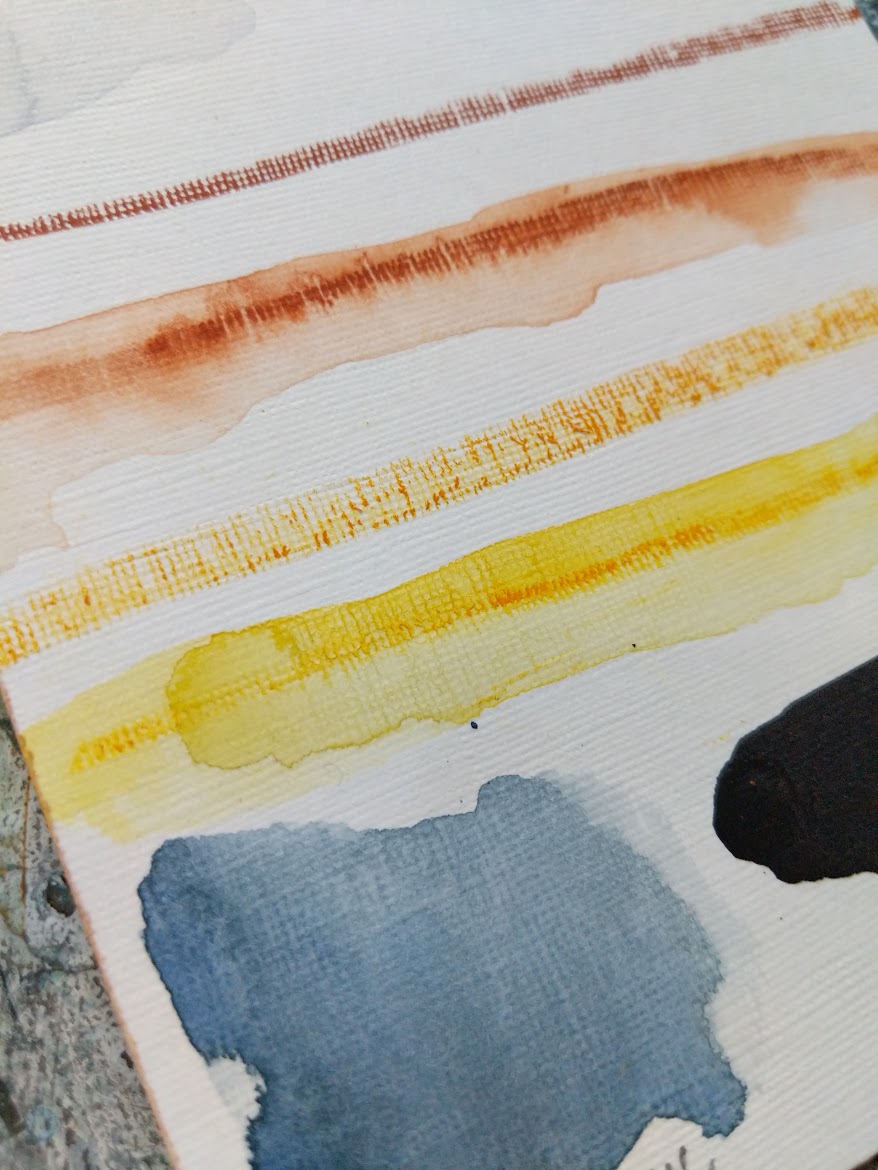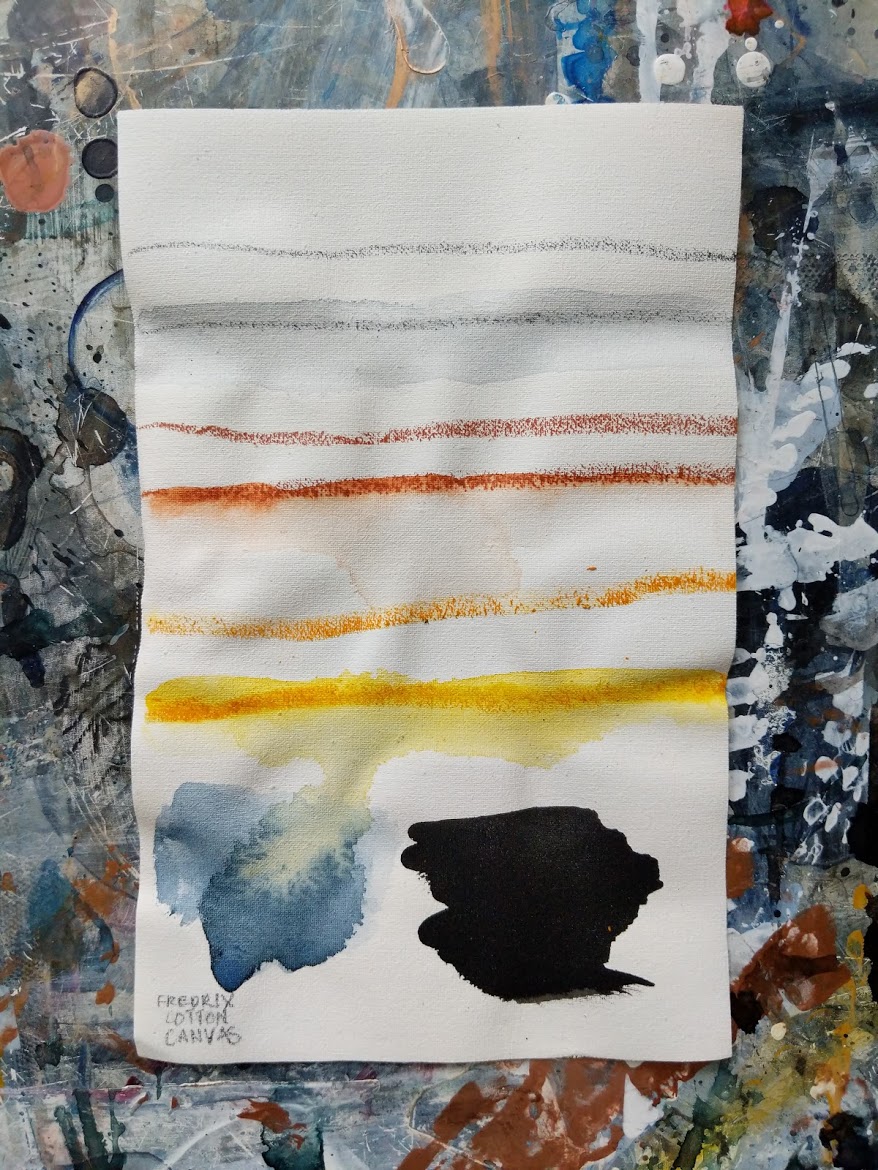Testing out Viviva Colorsheets
(( This is not a sponsored review, this is just me making a few color swatches and sharing the info <3 ))
I make a lot of work while on the go. Whether that’s an adventure abroad, or a coffee shop down the street I paint a fair amount outside the confines of my little studio and need small(ish) supplies to be able to do so.
And so, I am constantly on the look out for materials that will travel with me; tucked away inside a backpack or in a back pocket.
I had seen a few ads for these watercolor colorsheets from Viviva and found myself intrigued - but cautious. I’ve tried a few portable-themed watercolor paints that seemed great in theory, but didn’t really perform up to my standards, so I wasn’t overtly hopeful as I placed my order.
The colorsheets shipped from India and so took a little while to arrive (so keep that in mind if you order a pack for yourself!) but when they did I found myself getting more excited about trying these out. Slightly larger than a business card, these could bypass my backpack storage and go straight to my pencil case. That was an interesting thought.
How pretty is this rectangle of Viridian?
On trying them out, I was surprised. I expected patchy color, or a LOT of water application to loosen the pigments. Not the case. The brush glided across the surface and picked up SO. MUCH. PAINT.
In between each sheet is a page of wax paper, this is to keep the wet colors from sticking together (though it is recommended to allow each to dry before closing the book) and really enjoyed flipping through the pages. Some of the colors are so different from how they appear on the brush due to their concentration, it’s a bit magical to watch.
I made my swatches, noting how often I had to refresh my water due to the potency of the pigment. Definitely not what I was expecting.
I don’t know how long they will last, though I will continue to use these sheets and update here when I run out of a color. I also don’t know much about the archivability of the pigment, I wonder if a bit of added of water might make them run off the paper once painted? But for a small set to sketch with, these work really well. And the fact I can keep them in my pencil case and not even need an additional bag - even better!
What do you think of these? If you try them out I’d love to know how they work for you!
Acrylic Experiments on Fredrix Canvas Can-Tone Panels
In the years I’ve been sponsored by Fredrix Canvas I’ve been lucky enough to try out so many amazing surfaces to paint on. Their canvas has revolutionized my process and has given my paint life in a way that I simply haven’t found elsewhere. I’m grateful to be sponsored by them currently, but I also know that if there were to come a time when I’m no longer sponsored - I will always continue to buy their canvas. (Which is the reason I agreed in the first place, it’s seriously my favorite to work with.)
So recently I’ve been toning my own canvas in various shades, and have been super curious to try out these pre-toned canvas panels. I love the shade range, but was immediately drawn to Tara Gray and Georgia Peach first.
I started with a thinned acrylic titanium white, (for info on how I thin my paints check out this post) using a few different brushes to play with the spread of paint and the marks I could leave behind. After that had dried, I applied a layer of thinned indigo.
I love how the thinned paint dries on the panels - and how very different the paint looks from one to the other. I’ve got more layers planned for tomorrow once these are dry and I’m excited to see where they go!
Have you tried working on a toned surface before?
A Day in Life of my Sketchbook; featuring The Mercer Refillable Sketchbook from SLATE COLLECTION
Thank you to SLATE COLLECTION for kindly sponsoring this post. All opinions are 100% honest & completely my own.
One of the most important parts of my art practice is my sketchbook. (If you follow me on instagram, you’ve probably gotten that impression already.)
My paintings are an aggregate of so many different inspirations; contours of flowers, the colors of leaves on a run, words that stay stuck in my mind, patterns on the water, rhythms in remembered landscapes… all of these factors inform my work, so it is crucial that I have a sketchbook with me literally at all times, to record all of these.
Keeping a sketchbook is a discipline I cling to, rely on and owe much of my current practice to.
Currently I’m using the Mercer Refillable Sketchbook by SLATE COLLECTION and I’m in love with it. The cover is soft and supple (and in the case of my book, my favorite color; INDIGO!) and yet incredibly sturdy. I put my supplies through a lot, and it has held up beautifully.
How I use my sketchbook;
I get a fair amount of questions about my process when it comes to keeping a sketchbook, so I thought I might break down a typical day in regards to my sketching habits. I’d love to hear about your sketching routine too, make sure to leave a comment so I can learn about your practice!
7 am; Wake up (slowly, I’m awful at shaking sleep!) and quickly record thoughts from dreams, or colors that creep into my pre-dawn thoughts.
These are small notes generally, unless I’ve had an amazing dream, or spent the morning lying in bed visualizing a new series. It’s important for me to have a sturdy sketchbook, as I don’t sleep with it, but if I’m scribbling notes during the night, it can get caught in between the bed and the frame pretty regularly. The Mercer is both thick and rigid enough that this isn’t a problem.
9 am: Back from my run, I’ll write down thoughts that I’ve mediated on, colors from our local landscape, lyrics or moments from the music that empowers my run, and I’ll start to make plans and notes for the day ahead.
(This particular morning was spent watching a few busy squirrels outside my studio window. I put the pencil on the page and dragged it around according to the squirrels movements. Like a little treasure map to their buried nuts.)
11-1 pm: Errands and meetings! I make notes in my sketchbook of orders that need to go out that day and any supplies that I’m low on. Since I’m already out and about, I try to schedule meetings and meet-ups around the same time (and, Ann Arbor has such great food that lunch meetings are automatically THE BEST). My sketchbook is in tow for all of this, acting as a list for supplies, and as a mini portfolio if I’m meeting with a client or gallery space.
2-3 pm: My favorite part. Unless I’m knee-deep in other paintings, this is my project time; when ideas take form and the next paintings in a series starts here. Here is where I distill morning sketches, break apart words that have been stuck in my head, examine memory, color, and make thumbnails.
These can be super clean, super messy, made with lots of types of paint, or just pencil - so it’s important to me to use a sketchbook that is multi-purpose. Paper that is too thin will tear with water, paper that is too thick feels too final and I’m less likely to get deep into the experiment phase. I’m looking for a quality paper that can take a few layers of exploration, and the pages of this sketchbook (Mercer Refillable from SLATE COLLECTION) are perfect for that.
Once I’m confident in the idea, the movement and color scheme of the piece transfers from my sketches to canvas as I begin to create the painting. If I’m not totally feeling the pre-painting sketches, I’ll just keep exploring the composition and colors in thumbnails until I feel like I’ve got a better handle on the message I’m trying to convey. Or, the idea gets scrapped / shelved for tomorrow and I’ll come back with fresh eyes.
10 -11 pm: A slow unwind. At the end of the day, orders shipped, progress made on paintings, space (relatively) clean, I like to take stock of the last 16 hours and make sure if any thought is still rattling around upstairs - that it is written and/or sketched out for tomorrow. I’ll use this time to journal in my sketchbook a bit, reflect on things from the day or the days to come.
Keeping a sketchbook and being disciplined about the process is a huge part of my practice, and using the Mercer Refillable from SLATE COLLECTION has been the perfect book to use for this. If you’re an artist looking for a new sketchbook (refillable too!) check out their books. And if you know an artist, none of us is ever upset at a new sketchbook for the holidays!
What sort of sketching schedule do you keep? Is it a daily activity or more of when the mood strikes? I love looking at other artist’s sketchbooks and hearing about their process - feel free to share your habits below!
Happy sketching friends!
The Scrap Box; my childhood paradise, my artist playground
The Scrap Box has been a staple in Ann Arbor since the early 80s, and was my absolute favorite place to go as a kid. Whenever there was a special event to celebrate, or I had a few extra bucks from chores - this is where I begged my parents to take me.
The Scrap Box is is a donation-based creative reuse PARADISE, filled with all sorts of odds and ends, like thin-chopped white tubing, fantastic spongy shapes, nylon in every color of the rainbow, green nettings, yarns, papers, pieces of wood…. I couldn’t attempt to name everything they have! It’s all been donated by area businesses/individuals and provides kids/artists/educators/explorers with access to neat materials for very cost.
The bulk room; my favorite place.
As a child I would make 3D paintings, sculptures and scenes out of these bits and pieces - now as a working artist it is my haven for still life supplies. Especially when I’m teaching a class or breaking down my process, having access to all this weird stuff is amazing.
And if I’m setting up a still life for just me, I really appreciate having a cache of items that I don’t necessarily understand (or know what they are!) to scatter on a table. It keeps me from assigning meaning to their placement and sketch.
I usually combine the Scrapbox treasures with a few vases/cups I picked up at our thrift store add some crumpled paper, then get to work.
This is one of my favorite exercises to start the day with, or if I’m feeling just a little stuck - making some interesting (not necessarily pretty!) arrangements and sketching from these tends to yield some results that beg other questions, that warrant more sketching and exploration.
On Saturday I’ll be taking these supplies with me up to the MSU Broad Art Lab - where I’ll be setting up a few of these still lifes and teaching a little workshop on my contour drawing process. There’s still a few spaces left if you are in the area!
It was so wonderful to walk into the Scrap Box this week and gather a few extra items for Saturday’s class. This is the first I’ve been in since we moved back and I already have plans for more of the materials I saw there. Walking through the barrels in the bulk room gave me the same feeling as way back when; (except that now I am tall enough to actually see into the barrels!) endless inspiration, limitless possibility and knowing that I’m about to need A LOT more glue.
<3
Paper Tests; My usual materials on sample cards
** (Disclaimer) I was a bit on the fence about putting this post together. Experimentation (and actually doing it on your own) is such an incredibly important part of the process that I wondered if this piece was doing anyone any favors. And it really may not be - so please, don’t take these images and this text as your truth - GO GO DO YOUR OWN EXPERIMENTATION! Everyone’s process is different, and what works for me may not for you - and vice versa. **
That said, here’s an intro to surfaces!
Terms:
Acid-free: Acids leftover from the processing phase can yellow papers with age. It’s always a good idea to make sure whatever you are using (not limited to paper, check your tapes too!) is noted as “Acid-free” for archival purposes.
GSM/LB: These numbers refer to the weight (in pounds) of 500 sheets of 22 x 30 paper. The heavier the paper, the more sturdy it will be. I tend not to purchase anything below 140lb, as I use a lot of water in my work and anything with a weight less than that is likely to buckle and need several rounds of stretching. My favorite papers are in the 300lb range, these do not require the same amount of stretching and can hold lots of watery applications.
Surface Type:
Cotton vs. Cellulose: Artist-grade papers are 100% cotton, Cellulose papers are a little more affordable (student-grade) but use fillers instead of the natural pulp.
Hot Press: The paper is smooth and not incredibly absorbent. Colors tend to stay more vibrant on the paper, but at the sacrifice of texture.
Cold press: Slightly more texture than hot. Medium absorbency, great for washes and heavy paints.
Rough: Lots of texture, very pebbled like appearance. Can be harder to create exact details as the heavy texture can distort lines, but excellent for large stains and washes.
Fredrix Watercolor Canvas: Nice heavy cotton, medium texture, great absorbency.
Strathmore Mixed Media (toned): Heavy, smooth paper - low absorbency, so lots of opportunity to move paint around.
Strathmore Acrylic: canvas-like texture, heavy weight and great absorbency.
Sometimes the paper weights will vary company to company, so again - experimentation is key! Occasionally there are deals on sample packs of paper, so keep your eyes peeled at local art shops and online!
Materials Used:
(Top to bottom on each sample card)
Derwent Graphite Wash Pencil
Caran d’Ache water soluble pastel
Daniel Smith Watercolor Stick
Winsor and Newton watercolor (tube)
Golden hi-flow acrylic
Brands Used: I picked the materials I use the most frequently to demonstrate the paint’s behavior on each surface - but definitely do your own tests before committing to an expensive product!
Results:
140 lb Hot and Cold Press on Cellulose:
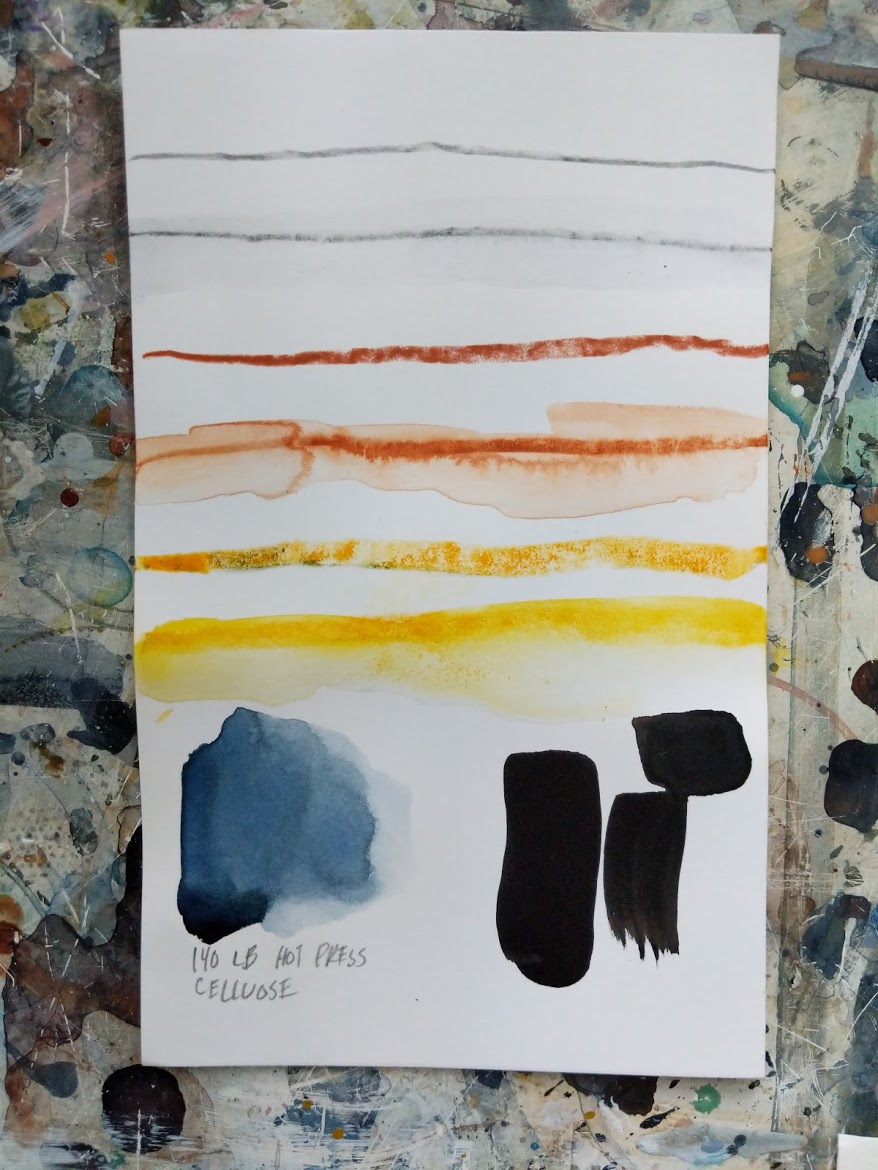
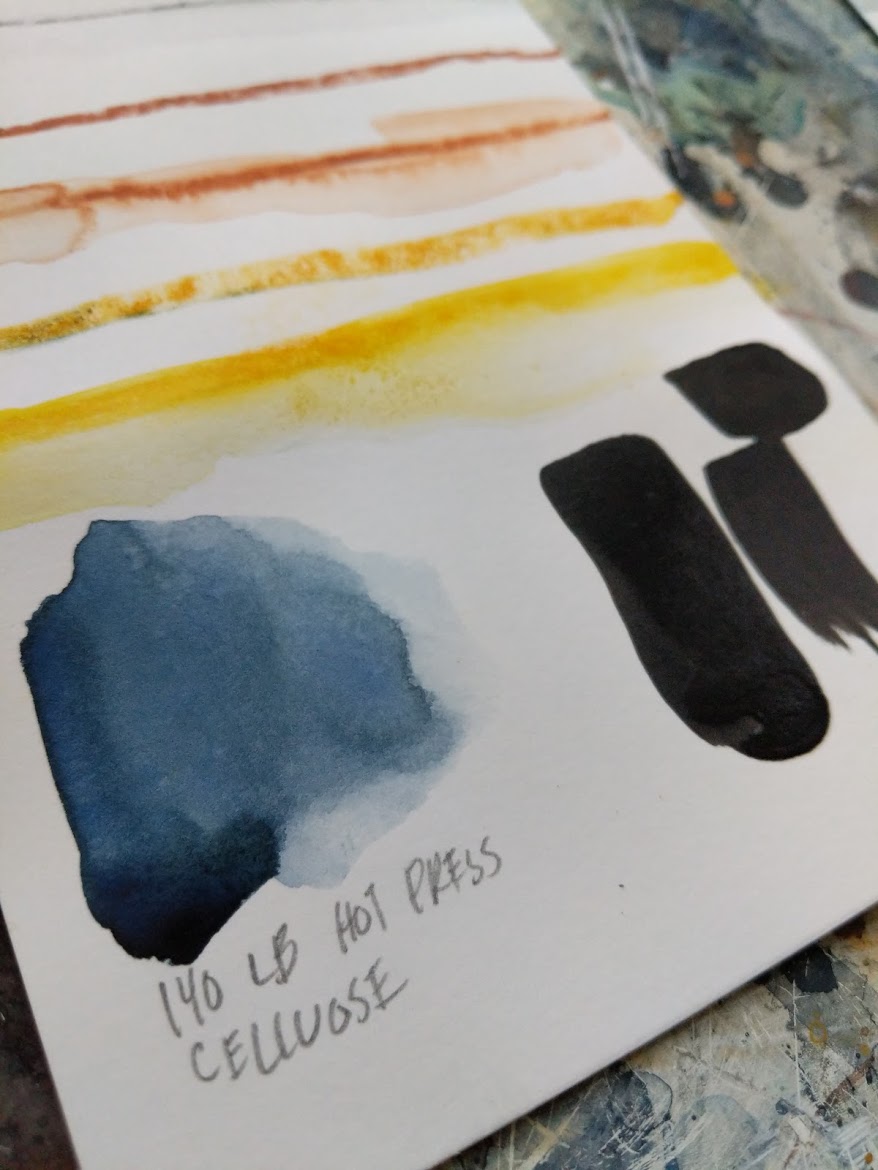
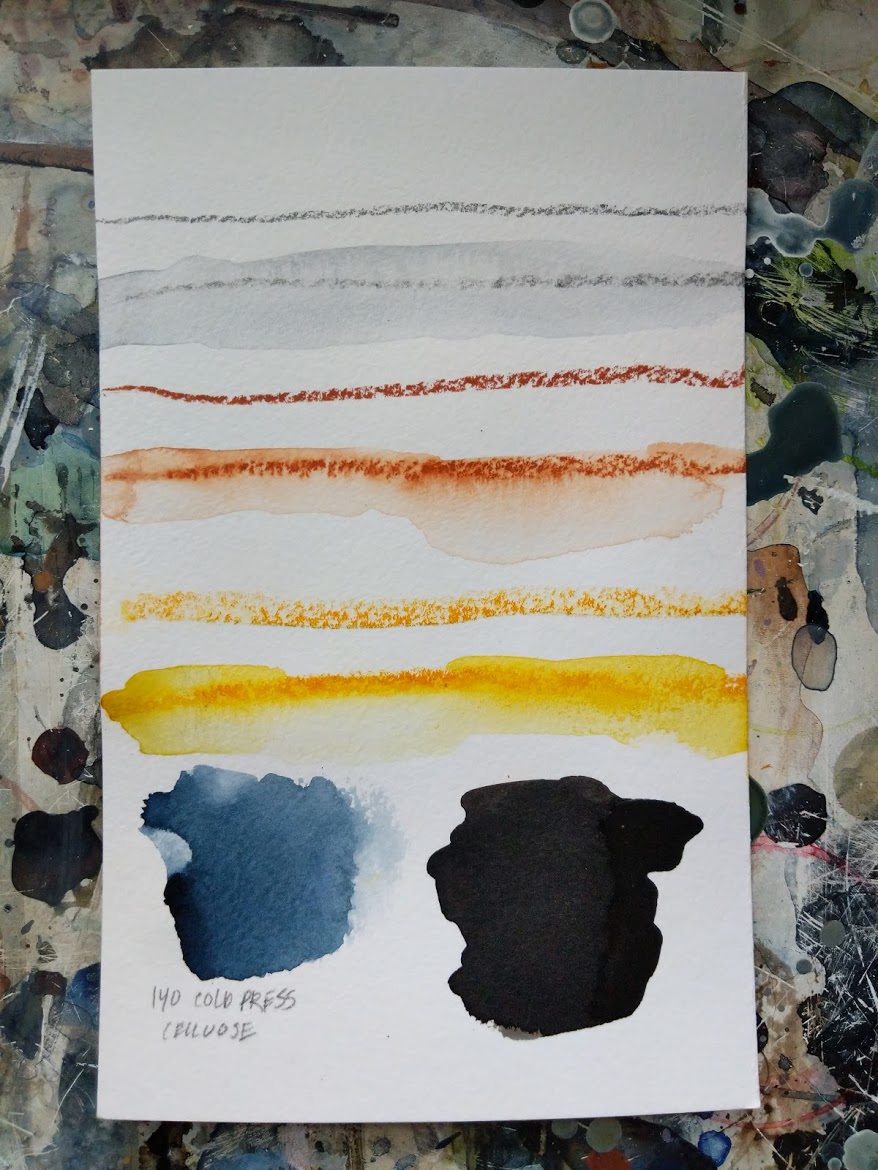
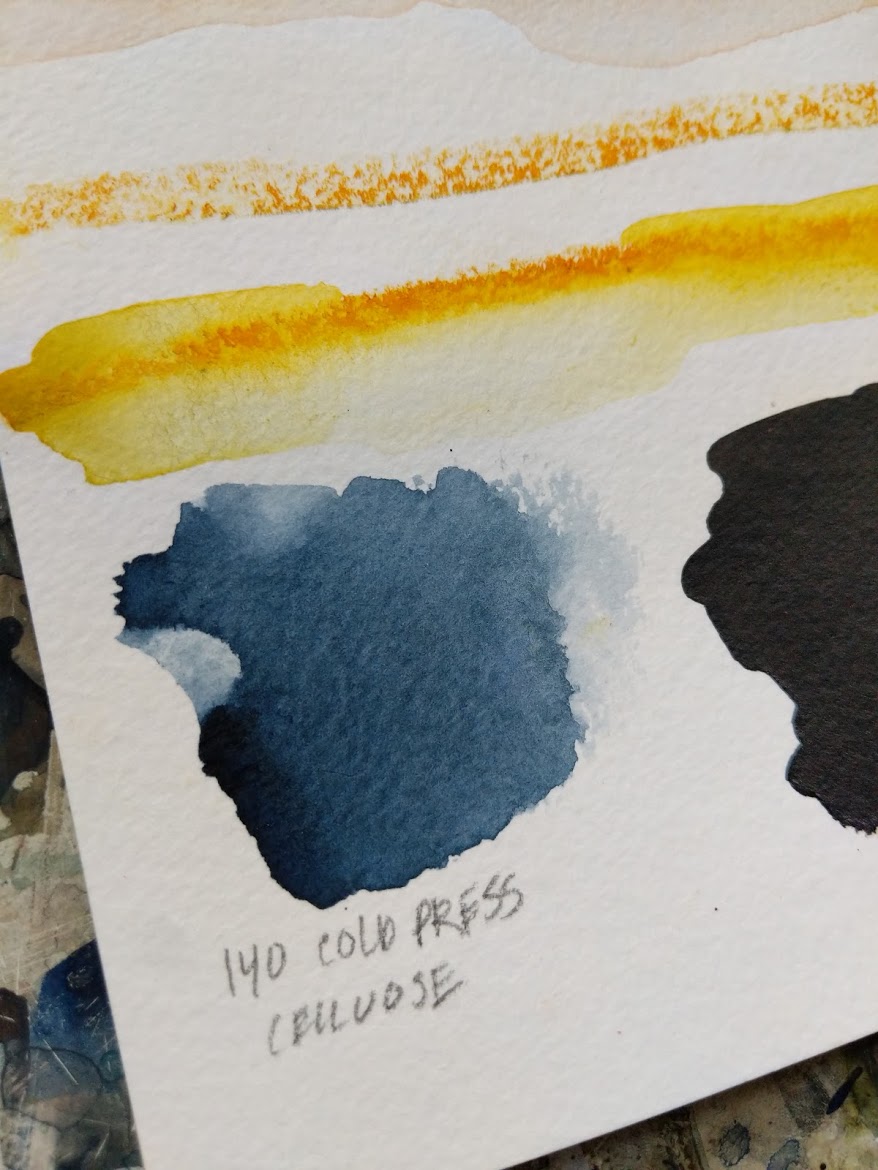
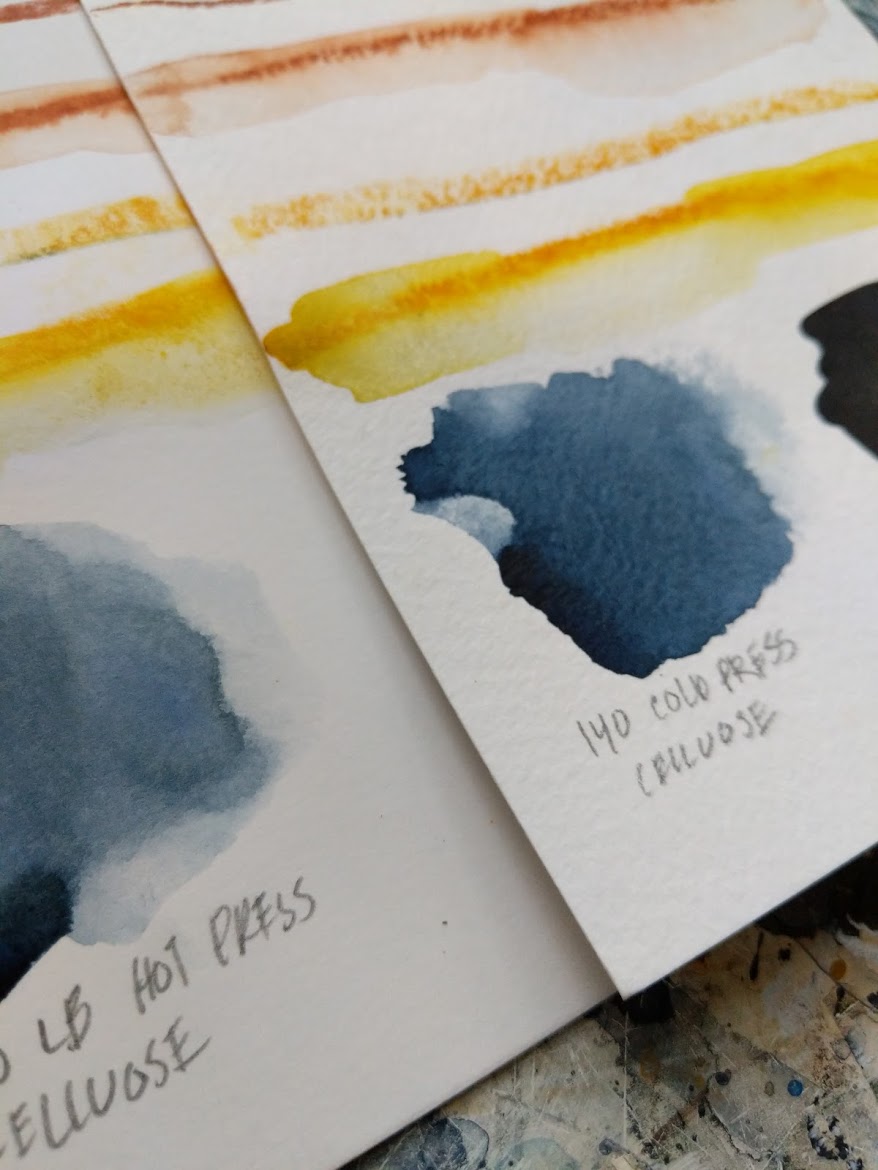
140 lb Hot and Cold Press on 100% Cotton:
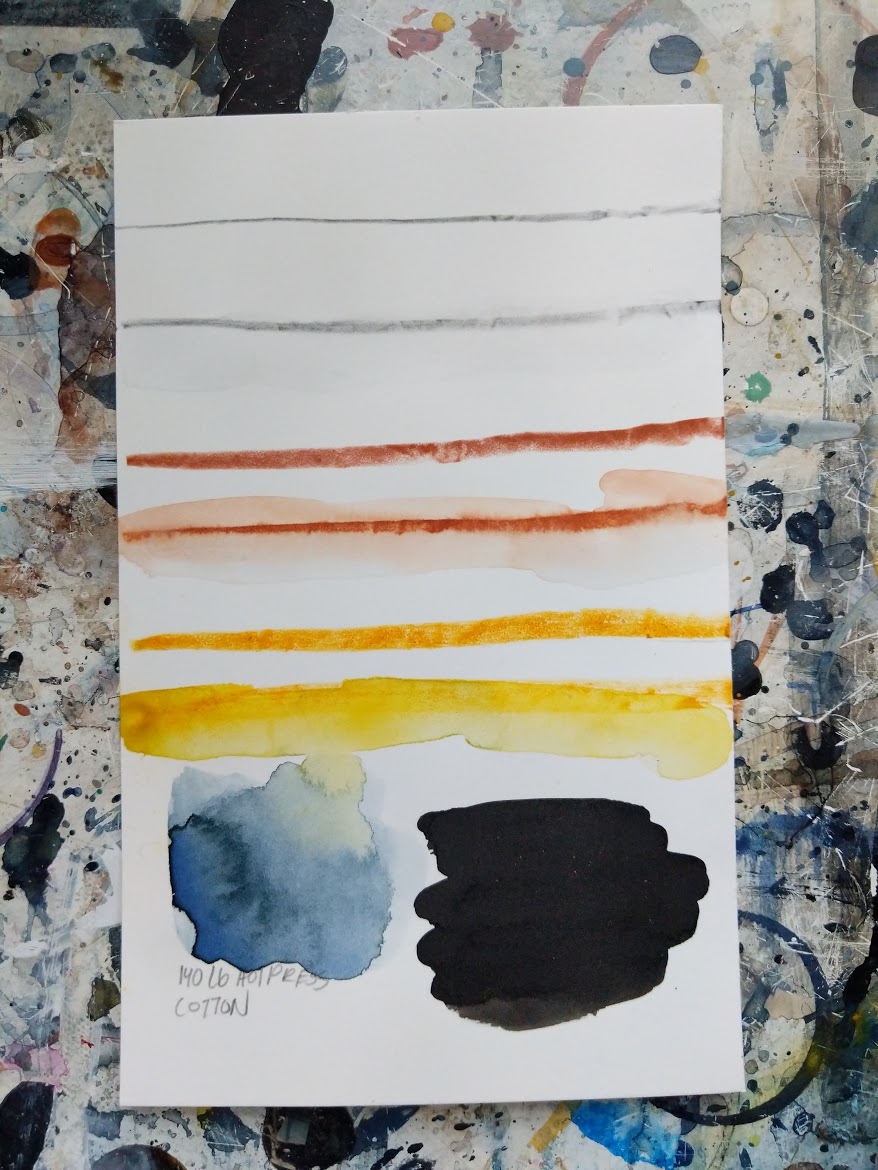
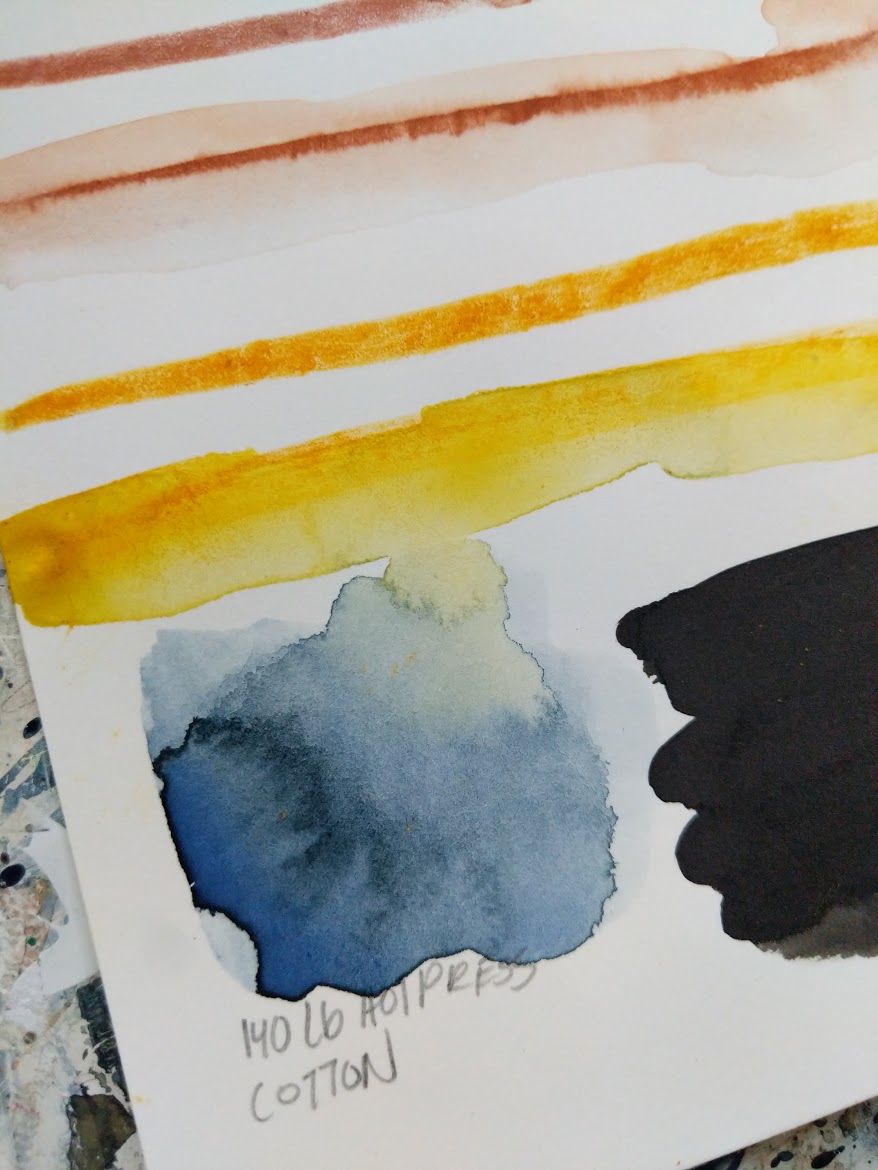
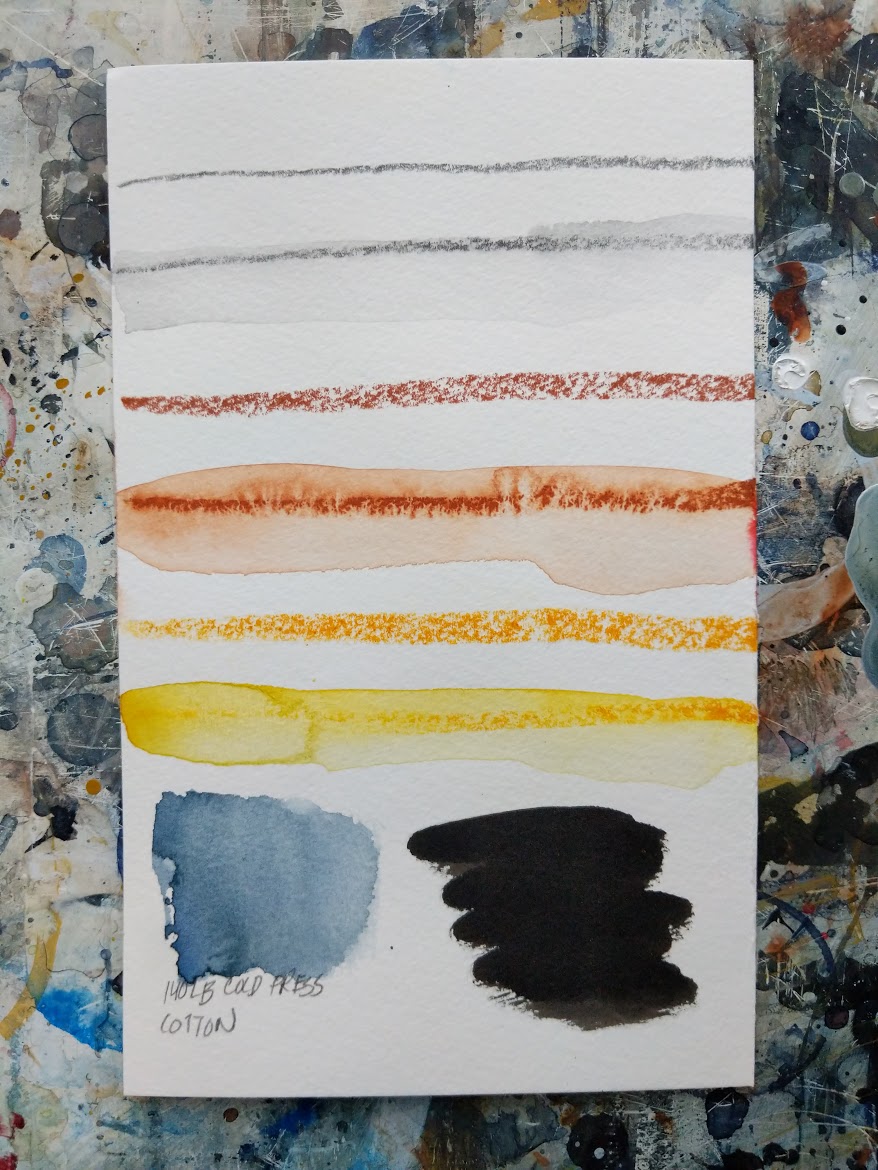
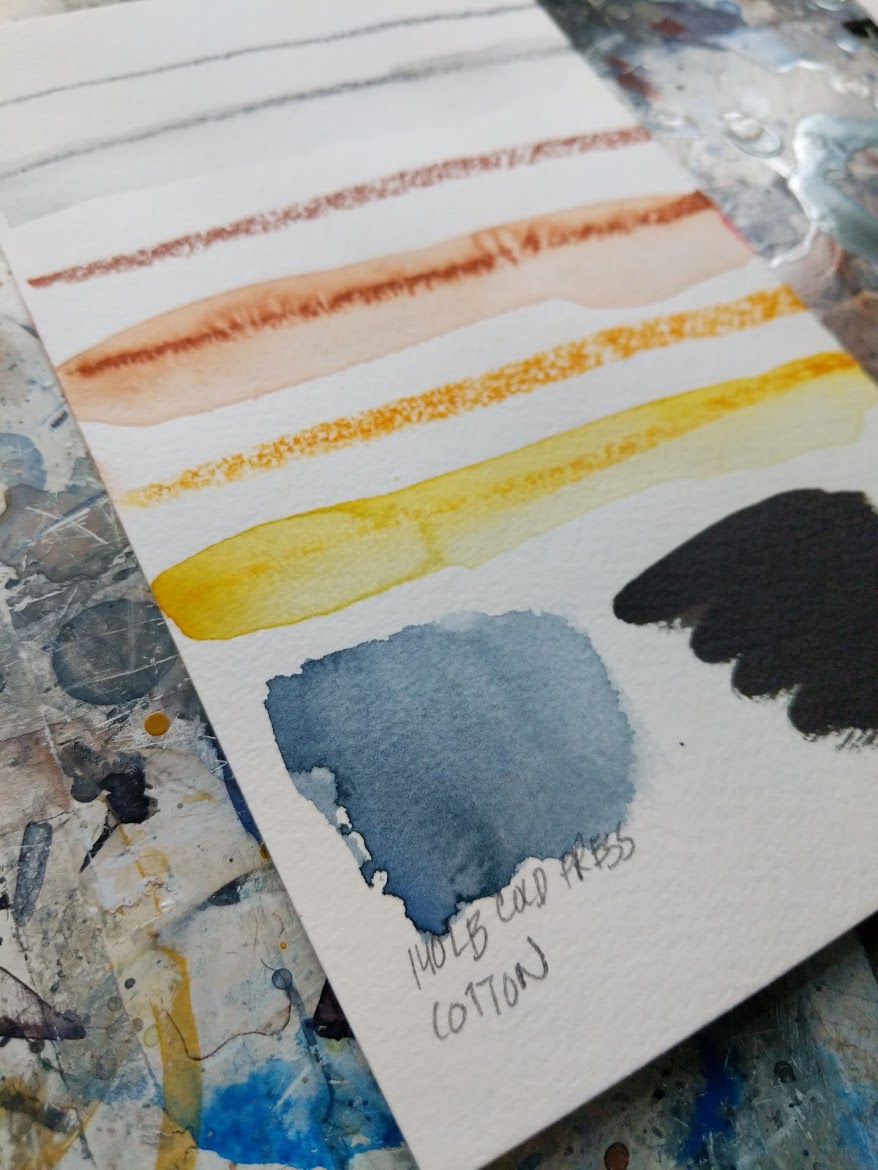
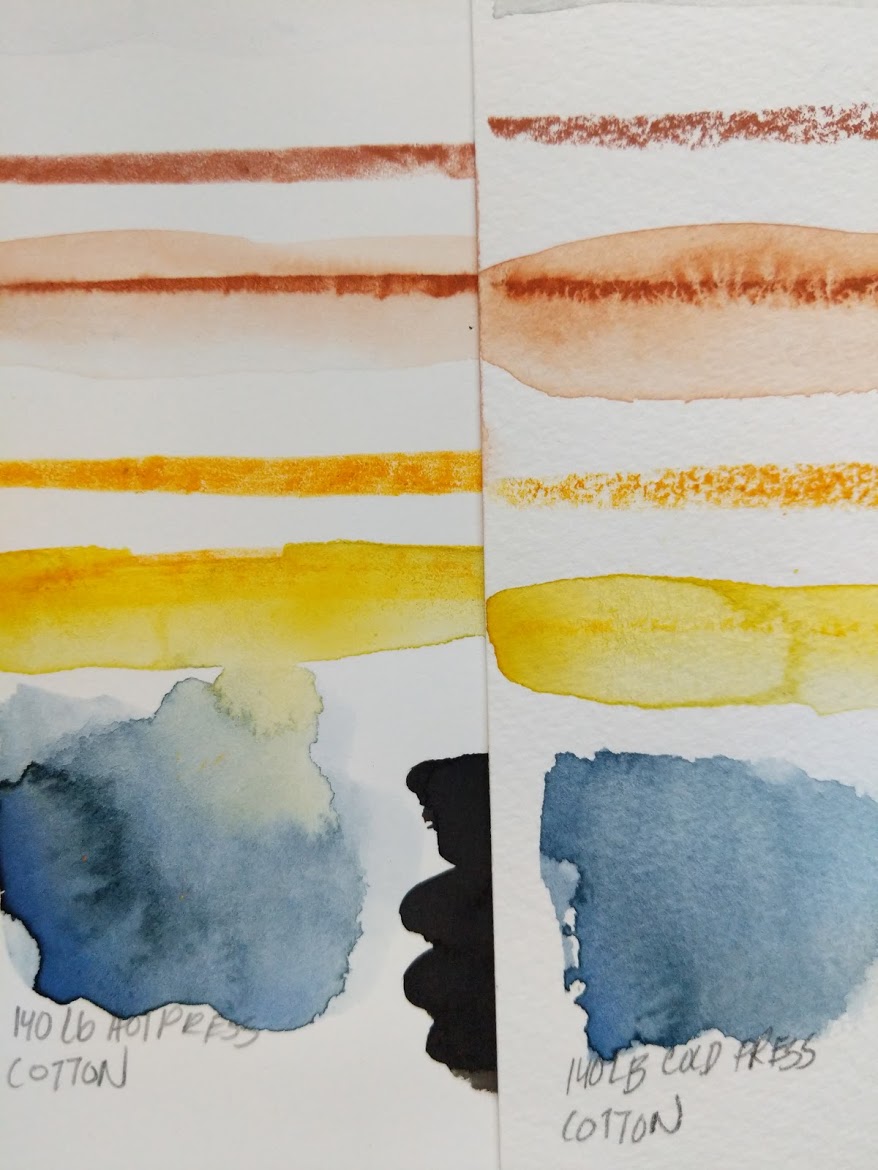
300 lb Cold Press Cotton:
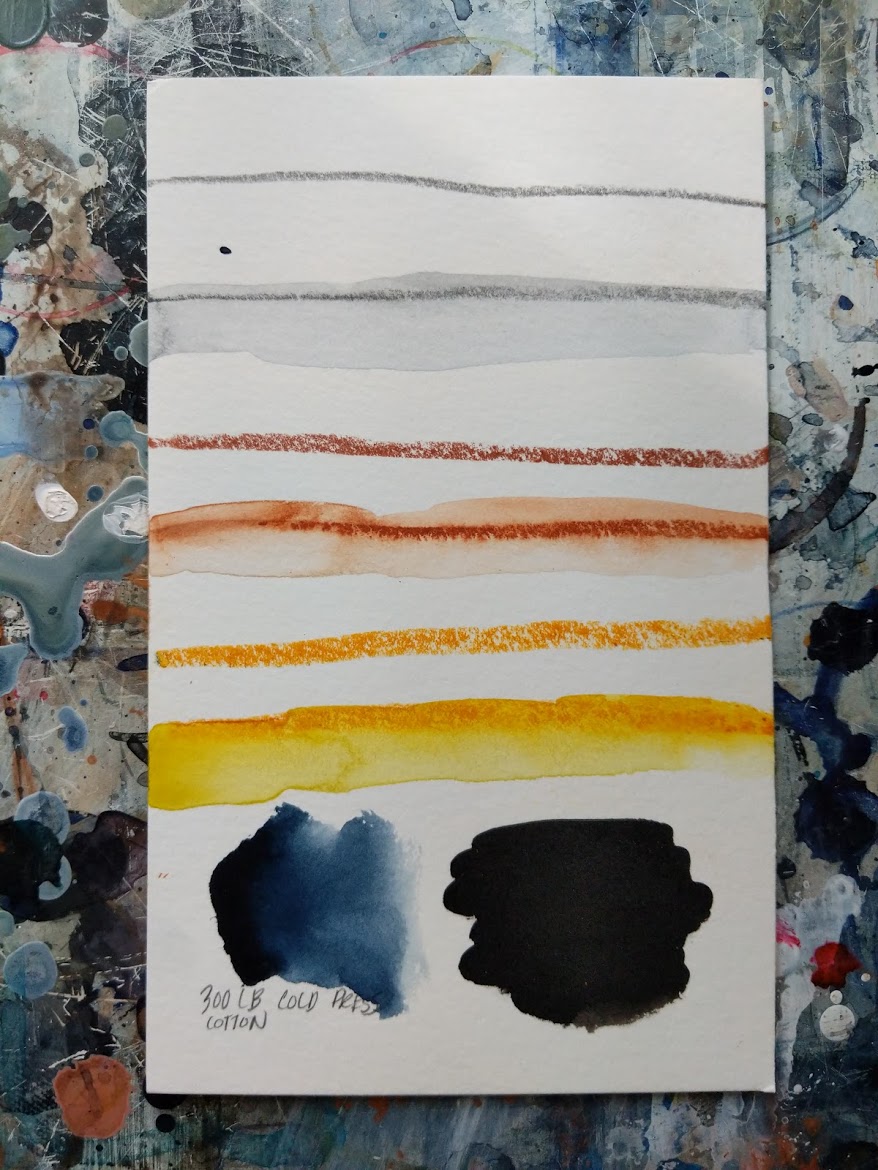
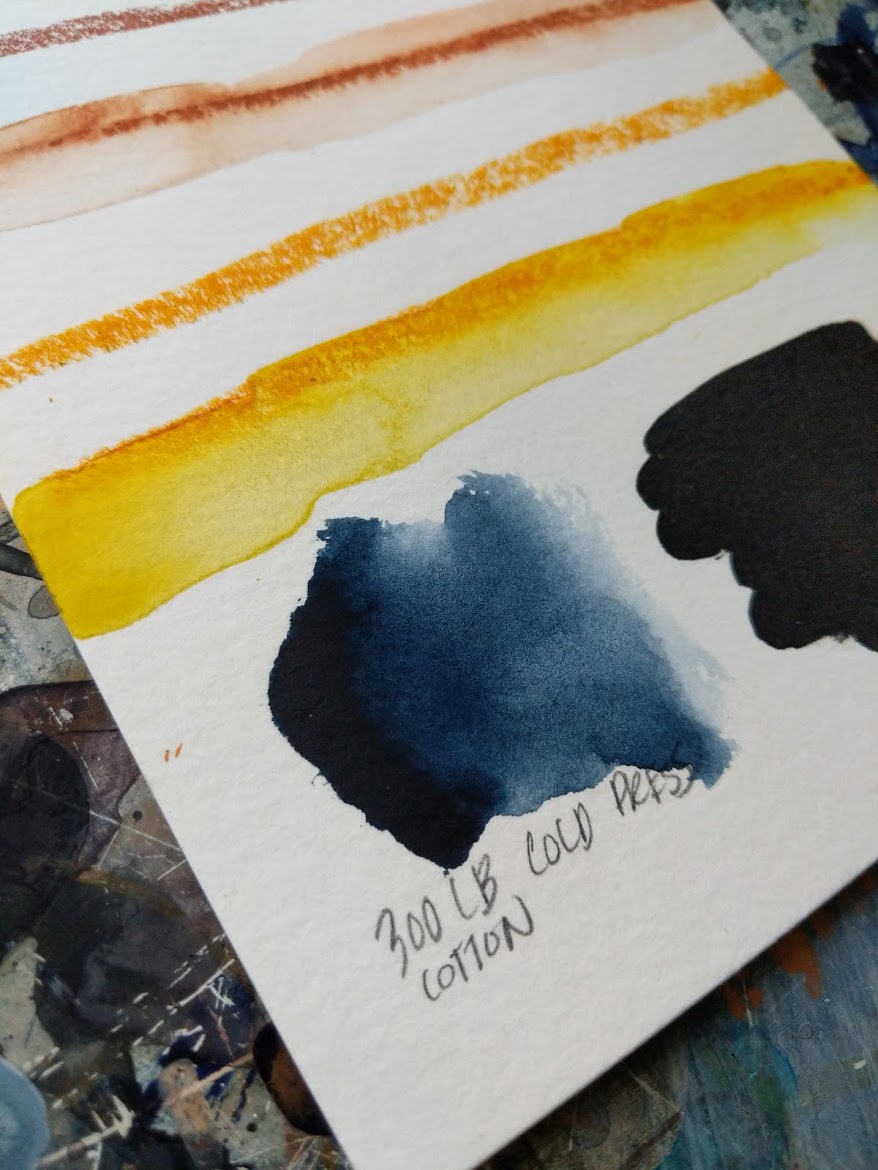
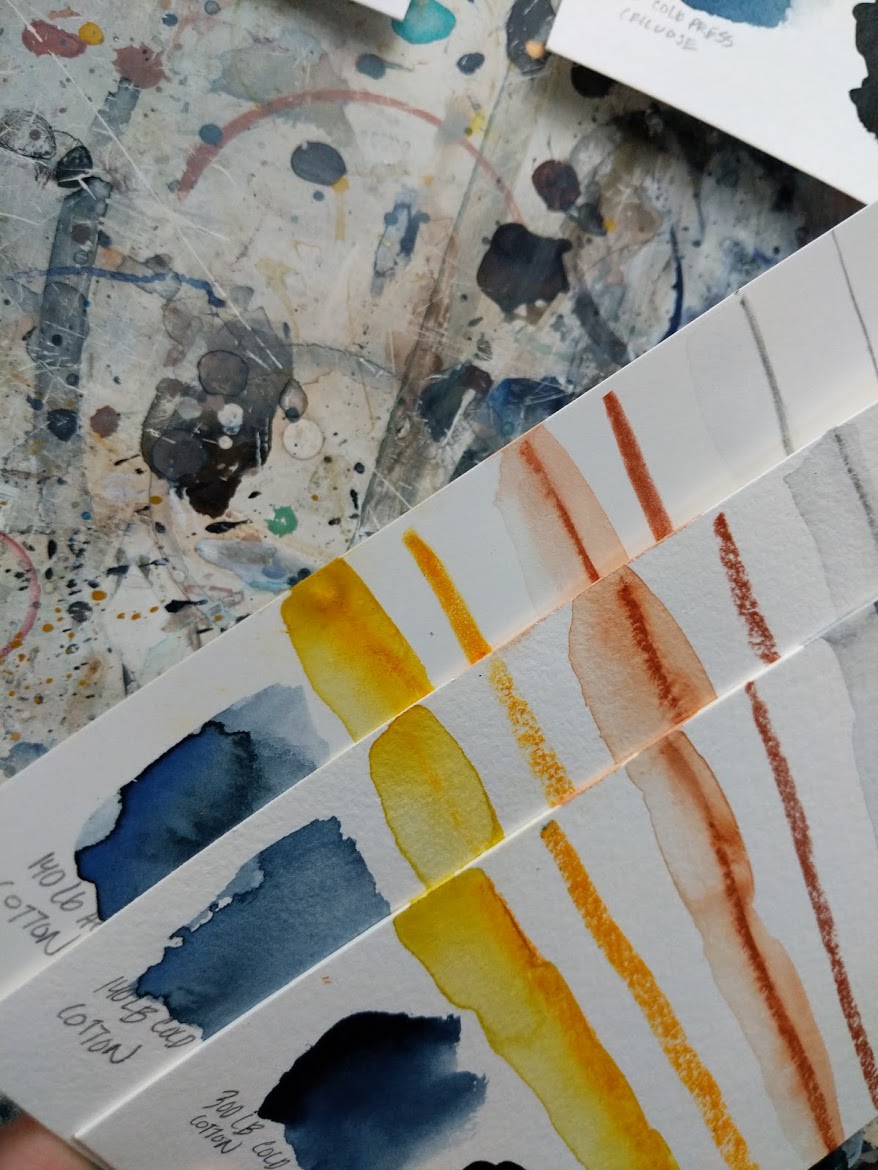
Additional Papers/Canvas:
Rough (Handmade):
Rough, heavy rag with great texture. Takes heavy water techniques really well.
Strathmore Acrylic:
Visible texture, great absorbancy - a little hard to get details into the texture.
Strathmore Mixed Media:
Excellent for multiple types of materials, my go-to for mixed media techniques. Available in non-toned colors as well!
Fredrix Watercolor Canvas:
Great absorbancy, not too fast in that I can still move pigment around - but not too slow in that it takes too long to dry. Holds mixed media great and has a nice canvas texture. Warping is to be expected (it is real canvas after all!) but is removed by stretching the back, ironing the back or dry-mounting. My go-to for travel watercolor work.
I had a lot of fun playing with all these papers and I hope this might be handy if you find yourself in a pickle choosing a surface! But again, it’s definitely so, so worth it to do your own tests as well, I never leave a pile of paper tests without learning something!
<3
